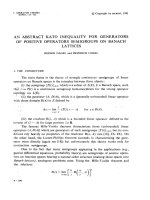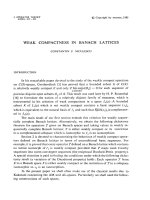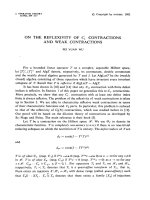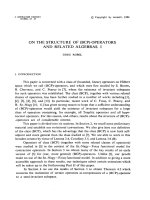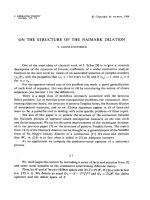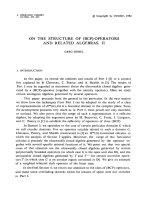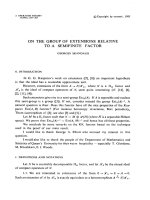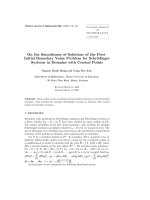Báo cáo toán học: "On the orbits of Singer groups and their subgroups" pot
Bạn đang xem bản rút gọn của tài liệu. Xem và tải ngay bản đầy đủ của tài liệu tại đây (113.26 KB, 10 trang )
On the orbits of Singer groups and their subgroups
Keldon Drudge
∗
Submitted: January 6, 2001; Accepted: March 5, 2001.
MR Subject Classifications: 05C88, 05C89
Abstract
We study the action of Singer groups of projective geometries (and their sub-
groups) on (d − 1)-flats for arbitrary d. The possibilities which can occur are de-
termined, and a formula for the number of orbits of each possible size is given.
Motivated by an old problem of J.R. Isbell on the existence of certain permuta-
tion groups we pose the problem of determining, for given q and h, the maximum
co-dimension f
q
(n, h)ofaflatofPG(n − 1,q) whose orbit under a subgroup of
index h of some Singer group covers all points of PG(n − 1,q). It is clear that
f
q
(n, h) <n−log
q
(h); on the other hand we show that f
q
(n, h) ≥ n −1 −2log
q
(h).
1 Introduction
A Singer cycle of a finite projective space Σ
n−1
=PG(n − 1,q) is a collineation σ such
that the group σ acts regularly on the points (and hyperplanes) of Σ
n−1
(the group is
then called a Singer group). The existence of Singer cycles is derived in [10] from the fact
that the multiplicative group of the field GF(q
n
) is cyclic. These distinguished elements of
the collineation group of Σ
n−1
have been used to construct many geometrically interesting
subsets of projective spaces (see, for example, [4], [9] and [6]). Glynn’s construction in
[9], in particular, amounts essentially to the determination of the orbits of such a cycle on
the set of lines of PG(3,q), and the basic geometrical structure of the sets of lines which
comprise orbits. This suggests the rather natural general problem of studying the orbits
of σ on the set of (d −1)-flats of Σ
n−1
for any d,2≤ d ≤ n −2(ad −1-flat is a subspace
of vector space dimension d). Here, motivated primarily by a problem in permutation
group theory (see Section 3), we determine, for arbitrary d and n, which sizes of orbit are
possible, and how many of each type occur. We also use the results so obtained to gain
some information on the orbits of subgroups of Singer groups.
Throughout, q will represent an arbitrary prime power, n ≥ 4 a fixed integer and σ
an arbitrary Singer element of Σ
n−1
. G = σ will denote the cyclic group generated
by σ. For any r ≥ 1 we will write θ
r
for the number of points of PG(r − 1,q), that is
∗
Research supported by an N.S.E.R.C. of Canada post-doctoral fellowship.
the electronic journal of combinatorics 9 (2002), #R15 1
θ
r
= q
r−1
+q
r−2
+···+1. As is well known, the function θ so defined satisfies (θ
r
,θ
s
)=θ
(r,s)
where (a, b) is the greatest common divisor of the integers a and b. Also, θ
t
r
will denote
thenumberofpointsofPG(r − 1,q
t
). Note that we have θ
n
/θ
r
= θ
r
n/r
whenever r|n.As
usual, we will use
n
d
q
to denote the number of (d − 1)-flats in PG(n −1,q).
Recall that an (r −1)-spread of Σ
n−1
is a set of (r −1)-flats which partition the points
of the space; an (r − 1)-spread exists if and only if r|n. We define a (k, r − 1)-cover of
Σ
n−1
to be a set S of (r−1)-flats such that every point of Σ
n−1
is on exactly k elements of
S (so an (r −1)-spread is the same thing as a (1,r−1)-cover). Counting flags shows that
for a (k, r −1)-cover to exist, k must be a multiple of θ
r
/θ
(r,n)
.SinceG acts transitively
on the points of Σ
n−1
, all orbits of (r − 1)-flats, r ≥ 2are(k,r − 1)-covers for some k,
and the previous sentence becomes the statement that the G-stabilizer of any (d −1)-flat
is contained in σ
θ
n
/θ
(n,d)
. The following lemma generalises this observation slightly.
Lemma 1.1 If a flag X ≤ Y with X a (d −1)-flat and Y a (r − 1)-flat is fixed by some
subgroup σ
k
of G then k isamultipleofθ
n
/θ
(n,d,r)
.
The (k, r − 1)-covers generalize to flats of arbitrary dimension the k-covers of lines
introduced by Ebert in [5].
We will say that an (r −1)-spread S of Σ
n−1
fills a(d−1)-flat X (d ≥ r) if any element
of S is either contained in X or disjoint from X—that is, if S defines a (r − 1)-cover of
X. For this to happen, of course, it is necessary that r|d. Also, an (r − 1)-spread S of
Σ
n−1
is said to be geometric if, for any two elements X
1
,X
2
∈S, S fills the (2r −1)-flat
X
1
∨ X
2
. The choice of language is due to the fact that
Lemma 1.2 An (r −1)-spread S is geometric if and only if taking as (k −1)-flats the set
of (kr − 1)-flats filled by S,fork =1, 2, ,n/r, and the inclusion inherited from Σ
n−1
gives a projective space PG(n/r − 1,q
r
).
2 Counting orbits
As we mentioned in the introduction, Glynn determines the orbits of a Singer cycle of Σ
3
on the set of lines (1-flats) of that space; his result is that there is one orbit which is a
(regular) spread, and that the other orbits are all (q + 1)-covers. This is indicative of the
following lemma, which provides the basis for Theorem 2.1.
Lemma 2.1 A Singer cycle of Σ
n−1
has an orbit which is a (d − 1)-spread if and only
if d|n. In this case there is exactly one such orbit S;theG-stabilizer of any S ∈Sis
Stab
G
S = σ
θ
n
/θ
d
. S is a geometric (d − 1)-spread and the factor group G/Stab
G
S is a
Singer group of the corresponding PG(n/d −1,q
d
).
Proof: The condition d|n is clearly necessary. On the other hand, if d|n,itiseasyto
see that any subspace of (vector space) dimension d which is closed under multiplication
the electronic journal of combinatorics 9 (2002), #R15 2
by a primitive θ
d
th root of unity is a multiplicative translate of a subfield GF(q
d
), so the
fact that the Galois group of the extension GF (q
n
)/GF (q) is cyclic of order n implies that
in this case exactly one orbit S of G is a (d −1)-cover; the stabilizer of any of its elements
is σ
θ
n
/θ
d
and the factor group G/Stab
G
(S) acts regularly on S.NowifS
1
,S
2
,S
3
are
distinct elements of S and the (2d − 1)-flat S
1
∨ S
2
intersects S
3
non-trivially, say in a
(r −1)-flat then this flat is fixed by σ
θ
n
/θ
d
. But Lemma 1.1 shows that its stabilizer is
contained in σ
θ
n
/θ
(d,r )
,sowemusthaved = r. Therefore S
1
∨S
2
is filled by S,soS is a
geometric (r − 1)-spread. ✷
The following lemma strengthens the statement immediately before Lemma 1.1. It
shows that the action of a Singer group of Σ
n−1
on the (d−1)-flats is similar to the action
of a n-cycle of the symmetric group on n elements on the set of d-element subsets.
Lemma 2.2 The G-stabilizer of any (d −1)-flat has size θ
u
, and is therefore σ
θ
n
/θ
u
for
some u|(d, n). In other words, each orbit of G on (d −1)-flatsisa(d −1,θ
n
/θ
u
)-cover of
Σ
n−1
for some u|(d, n).
Proof: By the above, the stabilizer of any such flat has size dividing θ
(d,n)
.If(d, n)=1,
all (d − 1)-flats have trivial stabilizer, so the lemma certainly holds in this case. This is
the base of an induction on the number of divisors of (d, n) (counted with multiplicity).
Therefore given a (d − 1)-flat X whose stabilizer is σ
θ
n
/k
for some k>1, let u>1be
the least integer such that k|θ
u
.Sincek|θ
(d,n)
,wehaveu|(d, n) by the minimality of u.
Now the stabilizer of X is contained in the stabilizer of the elements of the (u −1)-spread
orbit S, which is isomorphic to PG(n/u−1,q
u
). In fact, this spread fills X—if any Y ∈S
intersects X in a (t −1)-flat, that flat would be fixed by σ
θ
n
/k
, but its stabilizer is con-
tained in σ
θ
n
/θ
(n,d,t)
,sok|θ
(n,d,t)
. Thus by the minimality of u,wemusthave(n, d, t)=u,
but t ≤ u so t = u and X is filled by S as asserted. This implies that X corresponds to
a(d/u − 1)-flat of PG(n/u − 1,q
u
). By the induction hypothesis, the orbit of X under
the Singer cycle of this group is a (d/u − 1,θ
u
d/u
/θ
u
r
)-cover of PG(n/u − 1,q
u
) for some
r|(d/u, n/u). Thus the orbit of X under G has size θ
u
θ
u
r
= θ
ru
, and since ru|(d, n)we’re
finished. ✷
In the statement of the following theorem, µ denotes the M¨obius function, the basic
properties of which can be found in, for example, [1].
Theorem 2.1 The number of orbits of a Singer group of Σ
n−1
on the set of (d −1)-flats
of Σ
n−1
is
1
θ
n
t|(d,n)
n/t
d/t
q
t
u|t
µ(t/u)θ
u
. (1)
If u|(d, n), there are exactly
θ
u
θ
n
t:u|t|(d,n)
µ(t/u)
n/t
d/t
q
t
(2)
the electronic journal of combinatorics 9 (2002), #R15 3
orbits of any Singer cycle of Σ
n−1
on (d − 1)-flats which form θ
d
/θ
u
fold covers of Σ
n−1
;
any (d −1) flat occurs in this way for some u|(d, n).
Proof: The formula (1) follows from (2) on summing over all divisors of (d, n)and
switching the order of summation, so we need only prove the latter.
Once again, we proceed by induction on the number of prime divisors of (n, d). In the
case (n, d) = 1, the formula is clearly correct since every (d −1)-flat has trivial stabilizer.
Assume then that (n, d) > 1. Lemma 2.2 implies that every orbit of (d − 1)-flats is
a(θ
d
/θ
u
)-cover for some u|(d, n). This, together with the summation property of the
M¨obius function, imply after a little manipulation that the truth of (2) for u = 1 follows
from the truth of the same formula for every u>1. Thus we may assume that u>1.
Now any (d − 1)-flat X whose stabilizer is σ
θ
n
/θ
u
is fixed by exactly the stabilizer of
the unique orbit S of (u − 1)-flats which forms a spread of Σ
n−1
. This flat is therefore
filled by S (as in the proof of Lemma 2.2), so X is a (d/u −1)-flat of the PG(n/u −1,q
u
)
corresponding to S. Now the orbit of X as a (d − 1)-flat of PG(n −1,q) is the same size
as the orbit of X as a (d/u − 1)-flat of PG(n/u − 1,q
u
) under the factor group which
acts as a Singer group of the latter space. Thus the orbits of G on (d − 1)-flats whose
stabilizer is σ
θ
n
/θ
u
are in one to one correspondence with the orbits of the factor group
G/σ
θ
n
/θ
u
on (d/u − 1)-flats of PG(n/u − 1,q
u
) which have trivial stabilizer. By the
induction hypothesis there are exactly
θ
u
1
θ
u
n/u
t|(d/u,n/u)
µ(t)
n/tu
d/tu
q
tu
(3)
orbits of (d/u − 1)-flats which are θ
u
d/u
/θ
u
1
= θ
d
/θ
u
covers. Since the assignment t → ut
gives a one to one correspondence between divisors of (d/u, n/u) and divisors of (d, n)
which are divisible by u, the sum (3) is equal to (2), and we are finished. ✷
Remark: Theorem 2.1 shows that, perhaps as expected, ‘most’ orbits of (d −1)-flats are
acted on regularly by a given Singer group, since the term corresponding to t =1inthe
sum in (2), which only occurs in the sum for u = 1 (that is, trivial stabilizer) is far larger
than any other term in the sum. This implies that, although when (d, n) > 1 there will
be more than
1
θ
n
n
d
q
orbits of G on (d −1)-flats, this number is certainly a very good
approximation to the number of orbits in any case.
3 Permutation Groups
We now turn to the problem in permutation group theory which motivated both the
preceding and the following work on Singer groups.
It is a direct consequence of the orbit-counting lemma for permutation groups (see [2])
that every transitive permutation group G contains a fixed-point free element. A rather
the electronic journal of combinatorics 9 (2002), #R15 4
more delicate question, however, is what can be said about such elements. In particular,
under what circumstances can it be asserted that there exists a fixed-point free element
of order a given prime or prime power dividing the order of G? It was conjectured by
J.R. Isbell in 1959 that if the order of G is ‘dominated’ by a power of two, then G must
contain a fixed point free element of two-power order. His conjecture, generalized from
2 to an arbitrary prime p, is that there exists a function f
p
from the natural numbers to
itself such that, if G is a transitive permutation group of degree p
a
k with (k, p)=1and
a>f
p
(k)thenG contains a fixed point free element whose order is a power of p.Very
little progress has been made on this conjecture (see [3] for more detail, further references
and some theorems), and in particular it is not known whether or not f
p
(k)musttendto
infinity with k. The following construction was proposed by P.J. Cameron in an attempt
to give examples of transitive groups whose order is divisible by a large power of p but
which contain no fixed-point free p elements; I thank him for allowing me to include it
here.
Let V =(
/p )
k
with (k, p)=1,τ the automorphism of order k which cyclically
permutes the coordinate positions of V ,andG the group generated by V and τ (their
semi-direct product, since τ normalizes V ). Further, let W be a subspace of V ,sayof
co-dimension c, such that the union of all images of W under τ covers all elements of
V .ThenG acts transitively on the set W \G of right cosets of W in G (of size kp
c
)by
right multiplication; the stabilizer of the coset W is W and therefore the stabilizer of
acosetWτ
i
is the image of W under τ
i
. Since such elements cover all elements of V ,
and since the only elements of p-power order in G are those in V , G has no fixed point
free p-power elements. Thus if g
p
(k) is the maximum co-dimension of such a W ,wehave
f
p
(k) ≥ g
p
(k). Now the irreducible submodules of V as a τ module correspond to the
irreducible divisors of x
k
−1overGF (p) (see [8]); if for one of these irreducible submodules
V
0
there exists a /p -subspace W
0
of co-dimension c in V
0
whose images under τ cover
V
0
we may take the direct sum of W
0
with the other irreducible submodules to obtain a
subspace W of co-dimension c in V whose images under τ cover V , so we may reduce
to the consideration of the irreducible submodules, although it may not be the case that
a W with the largest possible co-dimension always arises in this way. The advantage of
the reduction, however, is as follows. Suppose that V
0
is an irreducible submodule of
/p -dimension n.ThenV
0
is isomorphic to GF (p
n
) (see [8]); the action of τ on V
0
corresponds to multiplication by a primitive kth root of unity. since k|(p
n
− 1), τ acts
on V
0
as a subgroup of a Singer group of PG(n −1,p) of index θ
n
/(k/(k, p − 1)).
Therefore we are led to the following problem: given a projective space Σ = PG(n −
1,q)where(n, q) = 1, and a subgroup H of index h in a Singer group of Σ, what is the
maximum co-dimension of a subspace of Σ which has the property that its images under H
cover all points of Σ? We denote this maximum co-dimension by f
q
(n, h). The case q = p
is prime and h = θ
n
/(k/(k, p −1)) with n =ord
k
p the order of p modulo k corresponds
to the irreducible submodules of (
/p )
k
,sowehaveg
p
(k) ≥ f
p
(ord
k
p, θ
n
/(k/(k, p−1))).
Since a set of (d−1)-flats of Σ whose union contains all points of Σ contains at least θ
n
/θ
d
flats, we must have h ≤ θ
d
; this implies that f
q
(n, h) <n−log
q
(h)−log
q
(q −1). Note that
the order of q modulo k is crucial to the decomposition of V =(
/p )
k
into irreducible
the electronic journal of combinatorics 9 (2002), #R15 5
submodules, and therefore to the index of the subgroup H which arises. For example, if
k = q
n
− 1, there are irreducible submodules of dimension n, and the subgroup H acting
on such a submodule considered as a PG(n−1,q) is actually equal to the full Singer group.
At the other extreme, if q is a primitive root modulo k, there are only two irreducible
submodules: one of dimension one and one of dimension k − 1. The subgroup of the
Singer group of PG(k −2,q) which arises in this case has size just (k −1)/(k −1,p−1).
In order, then, to use f
p
(n, h) to show that g
p
(k) and therefore Isbell’s function f
p
(k)
tends to infinity with k, it would be necessary that the actual value of f
p
(n, h)isvery
close to n −log
p
(h), at least in the case n = k − 1, h = θ
n
/((k − 1)/(k −1,p− 1)) which
corresponds to p a primitive root modulo k. In the next section it is proven that, in all
cases, f
q
(n, h) ≥ n −1 −2log
q
(h).
4 Orbits of subgroups of Singer groups
We begin with a simple combinatorial observation.
Lemma 4.1 If g ∈ PGL(n, q) acts fixed point freely then for any d, 2 ≤ d ≤ n − 1 we
have
X
|X ∩ Xg| = θ
n
n −2
d − 2
q
, (4)
where the sum is over all (d − 1)-flats X.
Proof: If d = 2, the right hand side of (4) is just θ
n
.Sinceg acts fixed point freely on
Σ, for each point P of Σ there is at most one line (2-flat) such that ∩g = {P }.Onthe
other hand, for each P , the line = Pg
−1
∨ P clearly has the property that ∩ g = P .
Thus to each point P there is associated a unique line = (P ) such that ∩g = P ,and
(4) is true for d = 2. Now for arbitrary d, we see that for a (d −1)-flat X which contains
apointP ,ifXg contains P then X must contain (P ), since otherwise we would have
P = X ∩ = Xg ∩ g = Pg. On the other hand, any (d − 1) flat on P which contains
certainly has the property that P ∈ X ∩ Xg.Sincethenumberof(d − 1)-flats on is
n −2
d − 2
q
the result follows. ✷
Now let G = σ be a Singer group of Σ = PG(n −1,q). Then for any (d −1)-flat X,
the orbit B of X under G forms a (θ
d
/θ
u
,d− 1)-cover of Σ for some u|(n, d), by Lemma
2.2. For each such orbit B, we define a function f
B
: G → by
f
B
(g)=
X∈B
|X ∩ Xg|. (5)
Note that, since G is abelian, f
B
(g)=|B||X ∩ Xg| for any X ∈B. Since the set of
(d − 1)-flats is partitioned into G-orbits and any element of G acts non-trivially, Lemma
4.1 says that for any non-identity g ∈ G we have
B
f
B
(g)=θ
n
n −2
d − 2
q
, (6)
the electronic journal of combinatorics 9 (2002), #R15 6
where the sum is over all G-orbits of (d − 1)-flats.
Theorem 4.1 Let G be a Singer group of Σ=PG(n − 1,q) and H ≤ G a subgroup of
index h.Ifforsomed we have h ≤
√
θ
d
then there exists an H-orbit of (d−1)-flats whose
union contains all points of Σ.
Proof: Since we don’t have any information on the intersection of H with the various
subgroups which occur as stabilizers of (d − 1)-orbits, we wish to restrict our attention
to the orbits on (d − 1)-flats with trivial stabilizers. As mentioned in the remark after
Theorem 2.1, almost all (d−1)-flats occur in such orbits. We wish to find an orbit B with
trivial stabilizer for which
g∈H\{e}
f
B
(g)(7)
is reasonably small. Now Lemma 4.1 shows that
B
g∈H\{e}
f
B
(g)=
n −2
d −2
q
θ
n
θ
n
h
− 1
. (8)
Even if it were the case that for every orbit with a non-trivial stabilizer the sum (7) was
equal to zero, there would still be an orbit B with trivial stabilizer for which (7) was at
most
n −2
d − 2
q
θ
n
θ
n
h
− 1
1
θ
n
t|(d,n)
µ(t)
n/t
d/t
q
t
(9)
by (8) and (2) (with u = 1). We claim that the sum (7) for this chosen orbit B actually
satisfies
g∈H\{e}
f
B
(g) ≤
θ
d
θ
d−1
(θ
n
)
2
θ
n−1
h
, (10)
that is that the right hand side of (10) is at least as large as the rather unpleasant looking
(9). This can be verified directly in the case d = 2 (using the assumption that h ≤
√
θ
2
).
If d ≥ 3 we proceed as follows. It is easily verified that the right hand side of (10) is
obtained from (9) by substituting θ
n
/h for θ
n
/h −1,
1
θ
n
n
d
q
for the denominator of (9),
and simplifying; the point is that (2) shows that the number of (d −1)-orbits with trivial
stabilizer is close enough to
1
θ
n
n
d
q
that these two substitutions result in a net increase
in quantity. This last claim follows from our assumption d ≥ 3 and the fact that for any
n and d,
n
d
q
is a polynomial of degree n(n −d)inq.
Thus we have shown that there exists at least one G-orbit B of (d−1)-flats with trivial
G-stabiliser which satisfies (10). Let P
1
, P
2
, ,P
h
denote the orbits of H on the points
the electronic journal of combinatorics 9 (2002), #R15 7
of Σ, and B
1
, B
2
, ,B
h
the suborbits of H on the (d −1)-flats of B . We define for each
j a function f
j
= f
B
j
(g)onH, by analogy with the definition of the f
B
.NowtheP
i
and
B
j
form a symmetric tactical decomposition of the tactical configuration whose points are
the points of Σ
n−1
and whose blocks are the elements of B. Therefore if we define a
ij
to be the number of points of P
i
whicharecontainedinagivenX ∈B
j
, a
ij
is also the
number of (d − 1)-flats in B
j
which contain a given P ∈P
i
, and counting flags gives, for
each j,
h
i=i
a
ij
= θ
d
h
i=1
a
ij
(a
ij
− 1) =
h
θ
n
g∈H\{e}
f
j
(g).
Now there exists some j for which
g∈H\{e}
f
j
(g) ≤
1
h
θ
d
θ
d−1
(θ
n
)
2
θ
n−1
h
by (10); adding the two equations above for this j gives
h
i=1
a
2
ij
≤ θ
d
1+
θ
d−1
θ
n
θ
n−1
h
.
If one assumes that some a
ij
= 0, the variance inequality implies that
h
i=1
a
2
ij
≥
1
h −1
h
i=1
a
ij
2
=
1
h −1
(θ
d
)
2
;
and after some manipulation this implies that h ≥ 1+
√
θ
d
. ✷
Corollary 4.1 The function f
q
(n, h) defined in the previous section satisfies f
q
(n, h) ≥
n −1 − 2log
q
(h).
Proof: For the stated inequality to be non-trivial, we must have h
2
<q
n−1
. Assuming
this, choose the smallest d such that h ≤
√
θ
d
. The inequality h>
θ
d−1
yields the
result. ✷
5 Concluding Remarks
As noted in the introduction, many interesting geometric objects arise as orbits of Singer
groups or subgroups of Singer groups. It seems, however, that only point (and, in the case
the electronic journal of combinatorics 9 (2002), #R15 8
of [9], line) orbits have been considered. Thus the question of determining the geometric
structure of the orbits of Singer groups on (d−1)-flats for arbitrary d arises. The simplest
non-trivial case is that of the (q + 1)-covers of PG(3,q) which arise as the line orbits with
trivial stabilizer of a Singer group. It is shown in [9] that these sets have the property
that the set of q + 1 line on a given point form a non-degenerate conic in the quotient
plane. Although this property is, for q odd, shared by the set of totally isotropic lines
of a symplectic polarity, B. Huppert ([7]) has proven that the largest cyclic subgroup in
PSp(4,q)hassizeq
2
+ 1; this obviously implies that the orbits do not have this structure.
We should also note that the argument in Section 2 goes through unchanged to give
the number of orbits of an n-cycle of S
n
, the symmetric group on n letters on the set of
subsets of size d. Furthermore, Lemma 4.1 can be generalised to arbitrary elements of
PGL(n, q), the result being that if g ∈ PGL(n, q) fixes exactly a points then we have, for
any 2 ≤ d ≤ n −1,
X
|X ∩Xg| = θ
n
n −2
d − 2
q
+ a
n −1
d − 1
q
−
n −2
d −2
q
.
Note that this is independent of the actual configuration of the set of fixed points. The
analogous result holds for elements of S
n
.
References
[1] T.M. Apostol, Introduction to analytic number theory, Springer-Verlag, New York,
1976.
[2] P.J. Cameron, Permutation Groups, Cambridge University Press, Cambridge, 1999.
[3] P.J. Cameron, Permutations, submitted to the proceedings of the conference
Paul Erd˝os and his mathematics
, held July 4-11 1999, Budapest.
[4] G.L. Ebert, Partitioning projective geometries into caps Can. J. Math. 37 (1985),
1163-1175.
[5] G.L. Ebert, The completion problem for partial packings, Geom. Dedicata 18 (1985)
#2, 261-267.
[6] J.C. Fisher, J.W.P. Hirschfeld and J.A. Thas, Complete arcs in planes of square order
Ann. Discrete Math. 30 (1986), 243-250.
[7] B. Huppert, Singer-Zyklen in klassischen Gruppen, Math. Z. 117 (1970), 141-150.
[8] F. J. MacWilliams and N. J. A. Sloane, The Theory of Error-Correcting Codes,
North-Holland Publishing Co., Amsterdam, 1977.
[9] D. Glynn, On a set of lines of PG(3,q) corresponding to a maximal cap contained
in the Klein quadric of PG(5,q), Geom. Dedicata 26 (1988) #3, 273-280.
the electronic journal of combinatorics 9 (2002), #R15 9
[10] J. Singer, A theorem in finite projective geometry and some applications to number
theory, Trans. Am. Math. Soc. 43 (1938), 377-385.
the electronic journal of combinatorics 9 (2002), #R15 10


